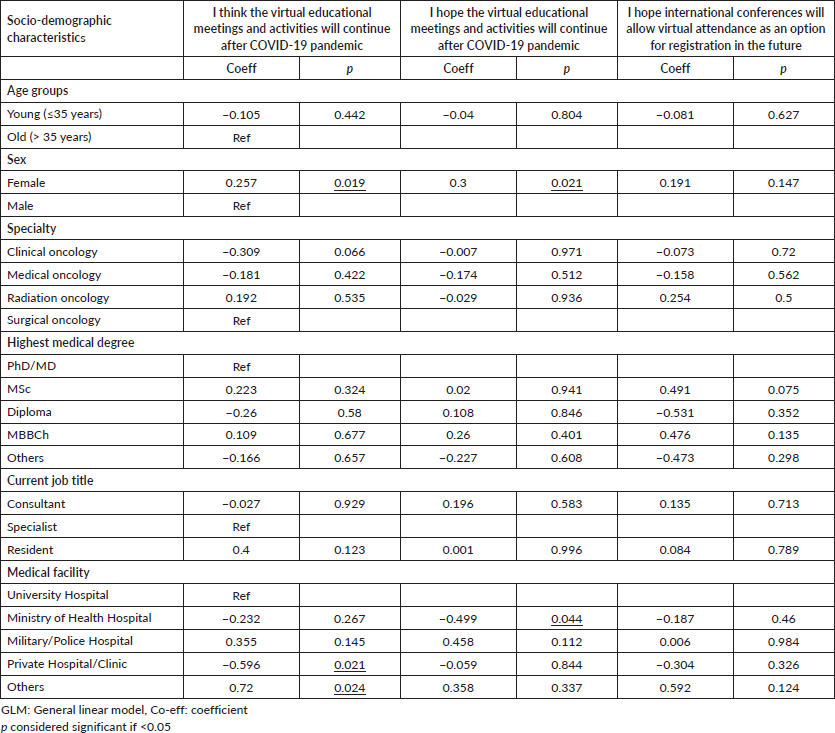Virtual educational meetings and activities during the COVID-19 pandemic and beyond: Egyptian oncologists’ experience
Mohamed Alorabi1, Ahmed Samir Abdelhafiz2, Nermen Mostafa1, Asmaa Ali3, Hagar Elghazawy1, Ahmed Mesbah4 and Abdul Rahman Jazieh5
1Department of Clinical Oncology, Faculty of Medicine, Ain Shams University, Cairo, 11591, Egypt
2Department of Clinical Pathology, National Cancer Institute, Cairo University, Cairo, 11792, Egypt
3Department of Pulmonary Medicine, Abbassia Chest Hospital, MOH, Cairo, 11517, Egypt
4Faculty of Medicine, Ain Shams University, Cairo, 11591, Egypt
5Department of Oncology, King Abdulaziz Medical City, King Saud bin Abdulaziz University for Health Sciences, King Abdullah International Medical Research Center, Riyadh, 11426, Saudi Arabia
Abstract
The COVID-19 pandemic has had ramifications for most healthcare activities, including medical education and communication aspects. Virtual educational meetings and activities (VEMAs) have been utilised tremendously in the pandemic era, reflecting a transition to new horizons of cyberspace. This creates the need to explore possible challenges for the implementation of such services in the rapidly evolving field of oncology. The aim of our study is to explore the impact of the COVID-19 pandemic on VEMAs in the oncology community in Egypt. It focused on the evaluation of current attitudes, satisfaction and expectations of Egyptian oncologists during and beyond the COVID-19 era. The study is a cross-sectional study using a survey that was distributed through social media. It targeted Egyptian oncologists during the months of May and June 2020. A total of 118 participants completed the survey and most of them were younger than 35 years (71%). Most participants (93.2%) agreed that COVID-19 affected the stream of live medical educational meetings. About three-quarters of them attended VEMAs during the COVID-19 period compared to 50% prior to the pandemic. The majority reported that evening hours after 8 PM was the best time to attend VEMAs and 1 hour is the optimal duration for a virtual meeting. Although the COVID-19 pandemic appeared as an unprecedented challenge for medical education, it can be a catalyst for VEMAs, especially in a rapidly evolving field such as oncology. Further research is needed to assess whether learners are ready and willing to make greater use of online educational platforms and investigate the possible barriers and strategies to enhance their use.
Keywords: COVID-19, pandemic, continuous education, virtual meetings, oncology
Correspondence to: Ahmed S Abdelhafiz
Email: ahmed.samir@nci.cu.edu.eg
Published: 16/08/2021
Received: 31/05/2021
Publication costs for this article were supported by ecancer (UK Charity number 1176307).
Copyright: © the authors; licensee ecancermedicalscience. This is an Open Access article distributed under the terms of the Creative Commons Attribution License (http://creativecommons.org/licenses/by/4.0), which permits unrestricted use, distribution, and reproduction in any medium, provided the original work is properly cited.
Introduction
Coronavirus disease 2019 (COVID-19) was first recognised in December 2019 in the city of Wuhan, China, and has spread to more than 200 countries in the world to date [1, 2]. The COVID-19 infection is mostly asymptomatic, but it can be fatal in 2%–3% of the cases from complications such as severe pneumonia, acute respiratory distress syndrome, septic shock and multi-organ failure [3]. The World Health Organisation (WHO) declared COVID-19 a public health emergency of international concern on 30 January and a pandemic on 11 March 2020 [4].
A few drugs and some vaccines have been approved for COVID-19. Prevention of the disease relies mainly on infection control measures such as hand washing, wearing masks, social distancing and quarantine [5, 6]. Many countries have imposed restrictions on travel in a way that has never happened before at such a scale [7]. They have also cancelled and banned mass gatherings and meetings [8].
These decisions have impacted healthcare education as many scheduled conferences, workshops and educational meetings in all fields including oncology have been cancelled, postponed or turned into a virtual format during the pandemic [9, 10]. Virtual meetings may have advantages, such as making it more convenient for more participants to attend, but on the other hand, they have drawbacks such as missing personal networking opportunities and experiencing the event first hand and in person [11].
Herein, we aim to evaluate Egyptian oncologists’ experience with virtual educational meetings and activities (VEMAs) during the COVID-19 pandemic, to correlate their use and attitude with different socio-demographic factors and to describe their needs and expectations for the post-COVID-19 era.
Subjects and methods
Study design and population
This cross-sectional study was conducted through an online survey for 2 months, i.e., between May and June 2020. The survey was completely anonymous. Data were collected through an online Google Forms platform. The inclusion criteria included clinical, medical, radiation and surgical oncologists practicing in the Egyptian healthcare system. The only exclusion criterion was practicing outside Egypt. The link of the survey was shared on social networking sites, including Facebook and WhatsApp groups, to the target population.
Study tool
The survey questionnaire was designed in English and consisted of four sections. The first section covered the socio-demographic characteristics of the participants. The second section evaluated the oncologists’ attitudes towards participation in the educational activities in the year 2019, prior to the COVID-19 pandemic. Questions in the third section assessed the participants’ experience and satisfaction with the VEMAs during the COVID-19 pandemic. The last section of the survey explored their needs and expectations regarding the future of the VEMAs in the post COVID-19 world.
Validation and pilot study
A preliminary phase was conducted to assess the validity and reliability of the questionnaire before its use. Initially, the first and the third authors, who are experts in the field of oncology and education, were asked to assess the degree to which items in the questionnaires are relevant to the goals of the study. Then, the questions were modified according to their response. After that, we tested the survey on 15 participants who completed it twice 2 weeks apart. The questionnaire had a high level of internal consistency and test-retest reliability, as determined by a Cronbach’s alpha of 0.814 and Pearson’s correlation of 0.66.
Sampling
The sample size was determined using the Epi Info 7 software. Depending on the previous study discussing the prevalence of attendance in E-learning classes (Journal club), it reached to 5%; thus, assuming that the confidence level was 95% with a type I error of about 5%, the minimal sample size was 73 participants [12].
Statistical analysis
The statistical analysis was carried out by Minitab 17.1.0.0 for Windows (Minitab Inc., 2013, Pennsylvania, USA). Continuous data were presented as mean and standard deviation (SD), and categorical data as number and percentage (%); the normality of data was examined using the Shapiro–Wilk test. The correlation between the attendance in VEMAs and participant characteristics was evaluated using chi-square test. The general linear model (GLM) was used to estimate the association between the different socio-demographic characteristics of the participants and the degree of agreement about VEMAs after the COVID-19 era, which is illustrated in three different questions using the Likert-type scale. All tests were two-sided, p was considered significant if ≤0.05.
Results
A total of 118 oncologists had completed the survey. Table 1 depicts the socio-demographic characteristics of the participants. More than half (54.2%) of the participants were male. The mean (SD) age of participants was 34 years (+5.99); most of them (71.19%) were younger in age (≤35 years). Most of the participants (67.79%) resided and worked (72.04%) in Great Cairo governate, and about half of them (48.3%) worked in university hospitals. About 56% were clinical oncologists. The remaining were distributed equally between medical and surgical oncology (18.6%) for each specialty, and radiation oncology (6.8%). Less than half of the participants (45.8%) had a master’s degree, and more than half (55.9%) were specialists.
Table 2 illustrates the oncologists’ experience in participation in the educational activities before the COVID-19 pandemic in the year 2019, where conferences were the most frequent activity, being attended by about 90% of them. This was followed by workshops (61%), webinars (36.4%) and journal clubs (36.4%). Most of them (68.6%) presented 0–3 lectures/abstracts/posters in these activities, which were mostly inside Egypt, while about 12% of the participants had presented >10 lectures/abstracts/posters. Almost two-thirds of the participants had received funding to attend these activities. Before the COVID-19 period, half of them had experience with VEMAs and almost all of them (96%) had attended <5 educational activities outside Egypt.
Most of the participants (93.2%) agreed that COVID-19 affected the stream of live face-to-face medical educational meetings. About three-quarters of them attended VEMAs during the COVID-19 pandemic with a maximum of once or twice a week (80.7%). Smartphones and laptops (72.8% and 51.7%, respectively) were the most used devices to attend VEMAs and Zoom was the most preferred platform (85.6%) (Table 3).
The evening after 8 PM was the best time to attend VEMAs in the opinion of the majority (83.9%). The optimum frequency and duration of VEMAs were once weekly (83.05%), and for 1 hour (64.41%), respectively.
Among the advantages of VEMAs, saving more time for family and social activities ranked number one (66.9%), followed by saving travel expenses (65.3%) and the availability of free educational content (62.7%). Sixty-seven percent believed that VEMAs fulfilled their educational goals and expected learning outcomes. On the other hand, problems with Internet connections ranked number one as a barrier for participation in VEMAs (66.9%), followed by the absence of travelling experience and the absence of interaction with other participants (56.8% and 44.1%, respectively).
While more than three-quarters of the participants believed that the information gained from VEMAs can be implemented in their practice, around half of them thought that VEMAs are generally useful for their work and development.
During the COVID-19 era, attendance of VEMAs was significantly associated with clinical and medical oncology specialty (p < 0.001), especially consultants (p = 0.01) with more experience (p = 0.05). There was no significant impact of age, sex, qualification degree or job facility sectors on the VEMAs attendance. The correlation between socio-demographic characteristics of the participants and attendance of VEMAs during the COVID-19 pandemic is illustrated in Supplementary Table 1.
When asked about their perceptions and expectations for virtual education after the COVID-19 era, about half of the participants thought that VEMAs will grow at the expense of traditional educational activities, 73.7% hoped that international conferences will allow virtual attendance as an option for registration in the future and 61% hoped that the VEMAs will continue after the COVID-19 pandemic (Supplementary Table 2).
Table 1. Socio-demographic characteristics of the participants (n = 118).
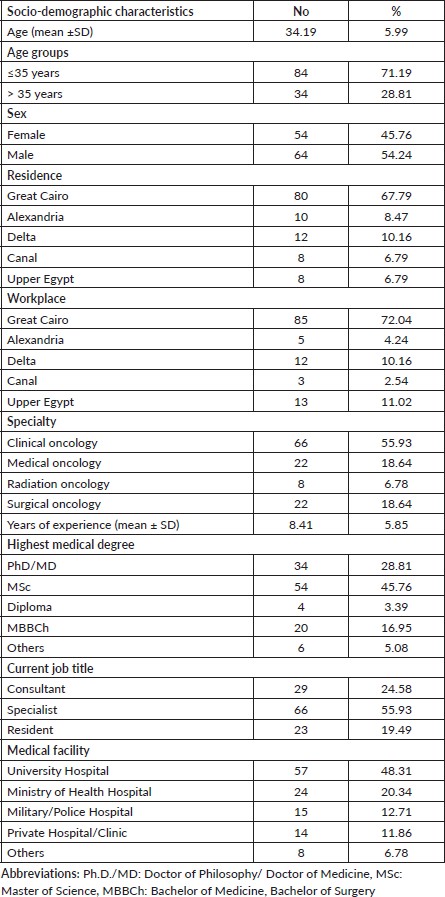
Table 2. Participation in the educational activities before the COVID-19 era (n = 118).
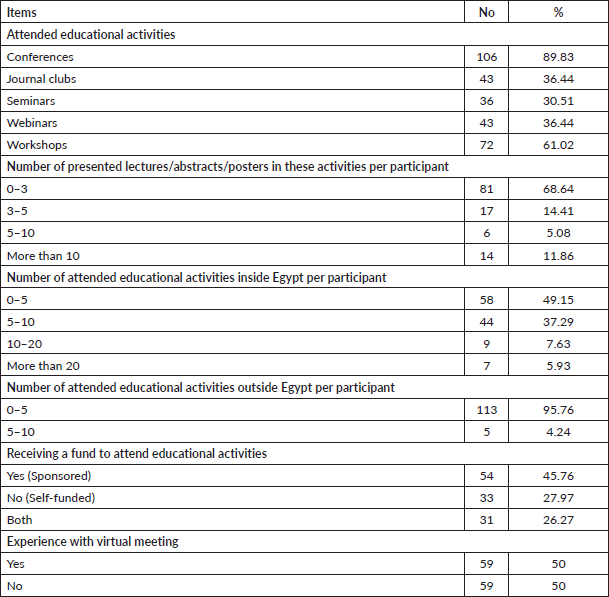
The correlation between socio-demographic characteristics of the participants and degree of perception about VEMAs in the post-COVID-19 world (Supplementary Table 3), quantified that females thought optimistically and hoped significantly about continuing VEMAs more than men (coefficient = 0.25 and 0.3; p = 0.019 and 0.02, respectively). On the other hand, doctors who work in the Ministry of Health (MOH) and private sectors showed significant disagreement about continuation of VEMAs after the COVID-19 pandemic (coefficient = −0.49 and −0.59; p = 0.04 and 0.02, respectively).
Discussion
Our study revealed a significant increase in participation in VEMAs, which is a reflection of the impact of the COVID-19 pandemic on the educational activities shifted to the virtual domain.
Most participants in this survey were young oncologists ≤35 years old. About half of them were in the middle of their career, being specialists and had their master’s degrees, which is the first step for specialisation in Egypt. At this point in their career, medical doctors seek knowledge to advance their skills and to establish their career in the field, while striving to get acceptable financial revenue. However, they do not have great scientific contributions, and they are not very well known to the scientific community. This is evident from the number of lectures/abstracts/posters presented by these participants in traditional educational activities, where about two-thirds of them presented only between 0 and 3 presentations last year. Also, data reflect the fact that conference attendance increases with career stages [13], and this may explain the age group of oncologists who showed interest in this study. In two other surveys about the experience of radiation oncologists [14] and ophthalmologists [15] with virtual learning during the COVID-19 pandemic, most respondents were young physicians less than 40 years, as in our study.
Approximately 70% of the participants strongly agree that the COVID-19 pandemic affected the traditional live medical educational meetings. As a result of this, there was an increase in their participation and experience with the VEMAs in comparison to the pre-COVID-19 era (74.58% versus 50%), which means that about a quarter of the participants had this educational experience for the first time due to the current circumstances. These results are in accordance with the findings of Chatziralli et al [15] in their survey about the use of e-learning in ophthalmology during the COVID-19 pandemic where 48% of participating ophthalmologists from both academic and non-academic institutions worldwide did not use any e-learning before the COVID-19 but during the pandemic there was a statistically significant increase in the use of all e-learning alternatives during the pandemic.
Table 3. Virtual educational meetings and activities (VEMAs) experience and satisfaction during the COVID-19 pandemic era (n = 118).
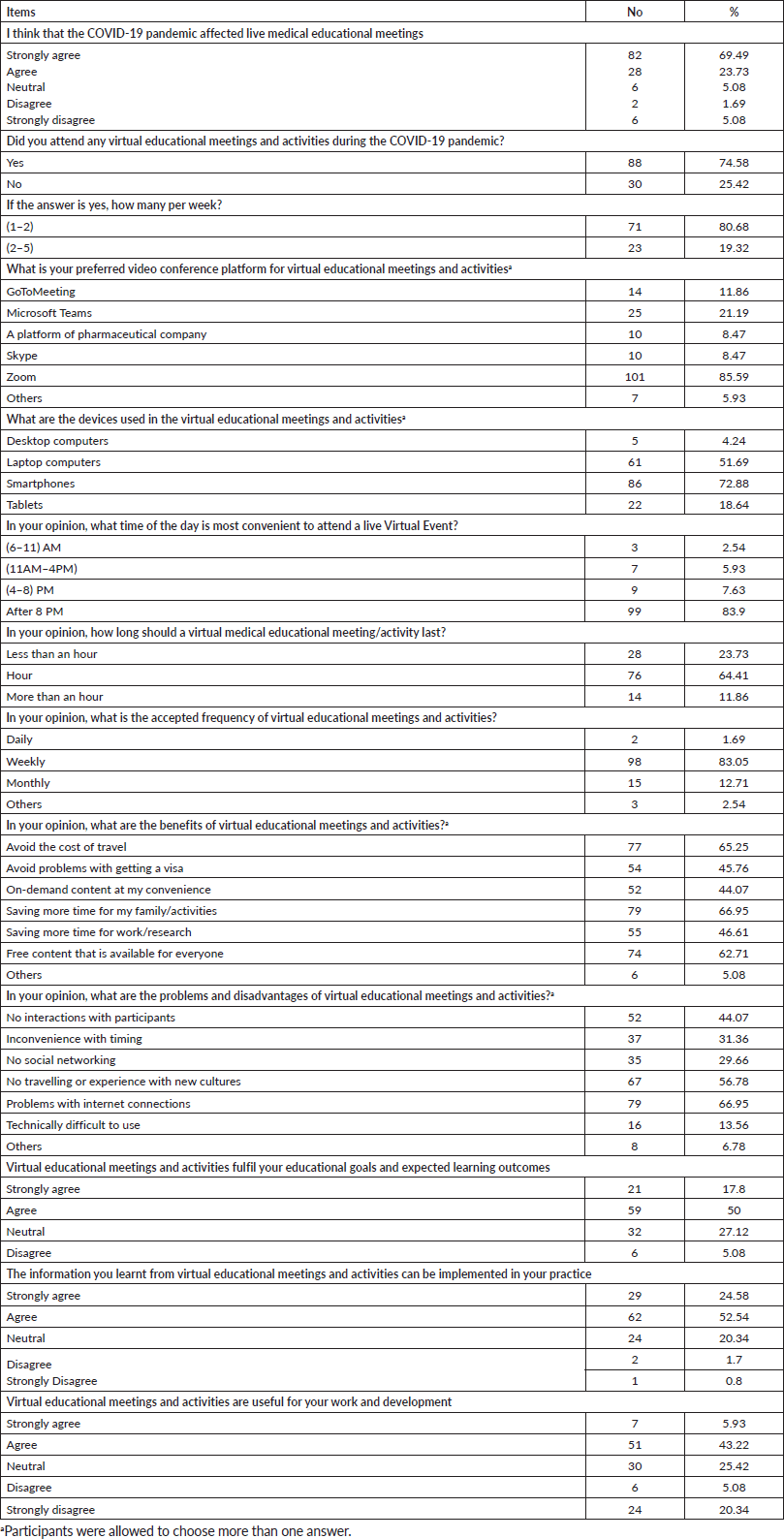
Selection of the right time, frequency and duration of educational activities is important to ensure that the message is delivered effectively. For example, The European Molecular Biology Organisation organised a virtual conference (T6SympoZOOM) between 15 and 17 April, 2020, during the pandemic. In the post-conference survey, 131 out of 181 respondents found the conference schedule with 2-hour sessions, 3 consecutive days and 10–15 minute talks as the most appropriate for them [16]. As a result of the cancellation of all major spine educational conferences in the first half of 2020, the Virtual Global Spine Conference (VGSC) was created in April 2020 by multi-institutional board-certified and board-eligible, spine fellowship-trained neurosurgeons and a board-certified interventional neuroradiologist in the form of biweekly virtual meetings every Monday and Thursday at 1000 and 1700 Eastern Standard Time, respectively, for 60–90 minutes [17]. In our study and from the answers, we can say that most of the participants prefer attending a maximum of one or two VEMAs per week, and in their opinion the most appropriate time to hold them is after 8 PM. Perhaps, they prefer this time because the majority would have finished their work, returned to home and had some rest before attending any VEMAs. Also, learning before night-time sleep has been shown to foster the consolidation of new memories [18], which may represent another advantage of this timing. Regarding the duration of the VEMAs, most participants believe it should be an hour or less. This is consistent with the fact that typical learner attention span wanes after about 15–20 minutes [19]. After 20 minutes, lectures become less effective for two reasons: working memory and interference, which make longer lectures both less enjoyable and less effective [19, 20]. Taken together, we think that scientific societies should take the perspectives of the audience into consideration while planning for their VEMAs. They should also be aware that delivering their content online at their homes does not mean the target audience will always be available to receive this content.
The affordable and easy access to smartphones in everyday social and work life of participants made them the preferred tool to be used in the VEMAs (72.9%). In one of the studies conducted on university students, it was found that 66% use mobile devices for e-learning, 45% used a mobile phone and 38% a laptop [21].
Zoom application was the preferred platform in our study to conduct VEMAs. Although not completely free, the application became very popular during social distancing time, recruiting millions of users and achieving great profits [22]. The application was the preferred platform for e-learning during the COVID-19 pandemic in many other studies [15–17, 23–25].
Education comes with a cost. Although free educational courses are now available online on multiple platforms, international conferences and workshops are expensive especially for early and mid-career physicians in developing countries [26]. Salaries for physicians in Egypt are among the lowest in the region [27]. That is why it is important for these physicians to get financial support to attend these meetings to cover the registration and travel costs. This was clear in the answers of our participants, where the great majority of them depended on external fund sources to attend educational activities. However, we did not ask about the source of this fund (whether it comes from their work place or pharmaceutical companies). This cost is usually obviated during VEMAs, which explains why participants considered that the major advantage of virtual education is saving money through the availability of free content. A Norwegian study about the benefit of 88 learners from online education in dermatology found that the participants saved 455,198 Norwegian krone in travel expenses [28], which is equivalent to 81,189 US dollars according to the average exchange rate in 2011 [29]. In another study about the impact of a Small private online course (SPOC) in oncology education and after comparison of the overall cost of the SPOC and the theoretical costs of comparable face-to-face education, the SPOC was a more cost-effective educational method (€148,000, versus €154,000 for face-to-face education) [30]. Although the fact that virtual conferences are supposed to consume lesser budget than needed by live conferences, still some landmark oncology conferences amid the COVID-19 pandemic require registration fees that reach 300$/participant [31]. The results of our survey guided the oncology community to exert their efforts to try to provide the VEMAs with amenable charges that can fit the lower income countries.
Burnout is common among oncologists including Egyptians as they have a stressful career [32–34]. The relationship with family members and practicing activities and hobbies are effective in reducing stress and overcoming burnout [35]. Flexible time management and saving travel time were advantages for online education according to students attending electrocardiogram course at the University of Ulm [36]. In this survey, it seems that social distancing, limited travel and VEMAs enabled our participants to save more time for family/activities. We think that this represents the other side of the coin, where physicians who were forced to ‘stay at home’ could regain their social life partially.
However, VEMAs lack some advantages which are provided by live events. Conferences and live educational meetings represent good opportunities for attendees to interact with their peers in the field as reported in a survey of travel behaviour among scientists in Germany. This is particularly important for early career doctors and scientists, where they can also have a chance to know about different cultures [13, 37]. A systematic review of the factors affecting e-learning in health sciences found that lack of interaction and collaboration between learners and facilitators is a barrier for this type of education [38]. This was evident in the responses of our participants, who reported the lack of interactions with other participants and experience with new cultures among the drawbacks of VEMAs.
Internet connection speed in Egypt improved in 2020 to rank number no. 2 in Africa, in comparison to 2017 [39], where Egypt’s Internet speed ranked among the world’s slowest [40]. However, a major problem with VM in this survey was the problem with Internet connection speed in Egypt, which indicates that major efforts should be carried out to overcome this problem and improve the speed. It seems that the problem with Internet connection and its speed is an obstacle to education in other countries as well. Healthcare worker in sub-Saharan Africa who completed the University of Washington School of Medicine online graduate course reported slow or limited Internet among the barriers to course completion [41]. However, in a survey about the online education for undergraduate health professional in Jordan during the COVID-19 pandemic, the lack of past experiences on using online tools was identified as the main barrier to e-learning among 75% of the participants in comparison to 13% in our study [42]. This difference may be due to the difference in age and experience between participants in the two studies.
A great majority of our participants believed that the information learnt from VEMAs can be implemented in their practice. This is similar to the results proved by other healthcare professionals, where distance learning was found to be effective for oncology nurses and neurosurgeons training [43, 44]. However, a fewer number of participants reported that VEMAs are useful for their work and development, which may reflect that the content should be more tailored to match their needs.
Certainly, the world will change after this pandemic in different aspects, including education with fears of a new recession and financial collapse [45]. VEMAs need less costs and arrangements. This may be why participants think and hope the VEMAs will continue and grow at the expense of traditional educational activities after the COVID-19 pandemic. These opinions and expectations are consistent with the opinions of other healthcare professionals, including neurosurgeons and orthopaedists, who intend to participate in e-learning activities after the end of this pandemic [43, 46]. Our respondents also hope international conferences to put virtual attendance as an option for registration in the future.
In the present study, the attendance of VEMAs during the COVID-19 era was significantly associated with the clinical and medical specialty (p < 0.001), especially consultants (p = 0.01) with more experience (p = 0.05), mostly because most participants were clinical or medical oncologists. Having more senior physicians attending these activities may reflect a targeted marketing to attract this particular group, or the ability to manage their time better to attend the meeting or being more experience in identifying these events and connecting with them. Around 1,000 Libyan doctors participated in a survey about the interaction of pharmaceutical company representative with doctors. There was a statistically significant difference in visiting rates based on the age group and all doctors older than 45 years who communicated with pharmaceutical company representatives [47]. Likewise, continuous medical education participation was more common among older Chinese doctors with intermediate or senior job titles in a nationwide cross-sectional survey [48].
E-learning may be more favourable for women through its flexible and interactive learning approach [49]. Interestingly, female participants in our study thought optimistically and hoped that VEMAs will continue more than male participants. Young female physicians often experience difficulty in returning to a clinical setting once they start having children and a Japanese nationwide cohort revealed that the proportion of female physicians who take leave is higher than the proportion of those who return to work [50]. We think that VEMAs are convenient for female doctors and may help them to achieve a balance between updating their knowledge continuously and caring for their homes and families. On the other hand, MOH and private sectors doctors were less optimistic about this point. This may reflect their need for more networking with their peers in other universities and with international experts as well.
The proposed strategies that could encourage oncologists to engage in future VEMAs include using attractive platforms for conferences as for instance the 3D interactive virtual platform and organising the VEMAs schedules to avoid overlapping. Moreover, CME accreditation and offering the lectures in recorded forms to be retrieved in the convenient time will up skill the oncologists’ carrier in real life. On the other hand, providing the chance for the junior oncologists to directly reach and get in touch with the oncology international experts and mentees in different fields virtually can greatly motivate them to attend these events and overcome financial obstacles for oversees collaborations and training. Finally, providing post-meeting satisfaction surveys for the speakers and attendees will help in evaluating and improving these services and upgrade its content.
To the best of our knowledge, there is no published data yet on the evaluation of the impact of the COVID-19 pandemic on virtual educational practices in the oncology field in Egypt or Arab countries. This research aims to explore the socio-demographic attributes of oncologists’ willingness to achieve virtual education, identifying the possible barriers for participation in these activities and clarify their needs for future events. In an attempt to improve the implementation of the VEMAs in the post-COVID-19 era, this study will enhance the technical skills of oncologists to use the virtual platforms in order to maximise the benefits of attending such meetings.
This study illustrated several important results by taking a snapshot for the current perspective towards VEMAs amid the COVID-19 pandemic. However, some limitations should be considered. Firstly, this survey was conducted and administered through social networking sites, including Facebook and WhatsApp groups, and this may result in sampling bias, e.g., most participants were young as only those who were interested and familiar with social media answered the survey. Secondly, the cross-sectional design of this study. Thirdly, limited sample size was among the study limitations. Fourthly, we did not evaluate the speakers or moderators’ experience as they may have different perspectives or needs. Fifth, we did not ask about hybrid meetings since they were not common options at the time of the distribution of the survey. Finally, and importantly, the participants’ perspective regarding the curriculum or the content of VEMAs was not deeply explored. VEMAs may represent a golden opportunity to exchange knowledge and experience with experts in the fields and follow the latest updates, but it is difficult to learn manual skills through them or utilise them when direct interaction with patients is needed. So, it is not possible to generalise this type of educational activities to all specialties and fields, which mandates a separate evaluation for other disciplines.
Conclusion and recommendations
The COVID-19 pandemic has led to new opportunities for virtual education. Curricula for this type of education should be developed and tailored according to the needs of target groups. Virtual registration and free content should be added as an option in future international scientific events to help young physicians in developing countries improve their knowledge and skills, without the need to bear the costs for travel and accommodation.
Conflicts of interest
The authors declare that they have no conflicts of interest.
Funding source
No source of external funding was received for this research.
References
1. Lee A (2020) Wuhan novel coronavirus [COVID-19]: why global control is challenging? Public Health 179 A1–A2 https://doi.org/10.1016/j.puhe.2020.02.001
2. Sun P, Lu X, and Xu C, et al (2020) Understanding of COVID-19 based on current evidence J Med Virol 92(6) 548–551 https://doi.org/10.1002/jmv.25722 PMID: 32096567 PMCID: 7228250
3. Guan WJ, Ni ZY, and Hu Y, et al (2020) Clinical characteristics of coronavirus disease 2019 in China N Engl J Med 382(18) 1708–1720 https://doi.org/10.1056/NEJMoa2002032 PMID: 32109013 PMCID: 7092819
4. Shi D, Lu H, and Wang H, et al (2020) A simulation training course for family medicine residents in China managing COVID-19 Aust J Gen Pract 49(6) 364–368 https://doi.org/10.31128/AJGP-04-20-5337 PMID: 32464736
5. Rismanbaf A (2020) Potential treatments for COVID-19; a narrative literature review Arch Acad Emerg Med 8(1) e29 PMID: 32232214 PMCID: 7085862
6. Abdelhafiz AS, Mohammed Z, and Ibrahim ME, et al (2020) Knowledge, perceptions, and attitude of Egyptians towards the novel coronavirus disease [COVID-19] J Community Health 45(5) 881–890 https://doi.org/10.1007/s10900-020-00827-7 PMID: 32318986 PMCID: 7173684
7. Devi S (2020) Travel restrictions hampering COVID-19 response Lancet 395(10233) 1331–1332 https://doi.org/10.1016/S0140-6736(20)30967-3 PMID: 32334692 PMCID: 7180010
8. Güner R, Hasanoğlu I, and Aktaş F (2020) COVID-19: Prevention and control measures in community Turk J Med Sci 50(Si-1) 571–577 https://doi.org/10.3906/sag-2004-146 PMID: 32293835 PMCID: 7195988
9. Almarzooq ZI, Lopes M, and Kochar A (2020) Virtual learning during the COVID-19 pandemic: a disruptive technology in graduate medical education J Am Coll Cardiol 75(20) 2635–2638 https://doi.org/10.1016/j.jacc.2020.04.015 PMID: 32304797 PMCID: 7159871
10. Kalia V, Srinivasan A, and Wilkins L, et al (2020) Adapting scientific conferences to the realities imposed by COVID-19 Radiol Imaging Cancer 2(4) e204020 https://doi.org/10.1148/rycan.2020204020 PMCID: 7294822
11. Killock D (2020) From the ASCO20 virtual meeting Nat Rev Clin Oncol 17(8) 449 https://doi.org/10.1038/s41571-020-0402-2 PMID: 32518328 PMCID: 7281699
12. Rosewall T (2012) The use of journal clubs in canadian radiation therapy departments: prevalence and perceptions J Med Imaging Radiat Sci 43(1) 16–25 https://doi.org/10.1016/j.jmir.2011.07.001 PMID: 31052015
13. Haage V (2020) A survey of travel behaviour among scientists in Germany and the potential for change Elife 9 e56765 https://doi.org/10.7554/eLife.56765 PMID: 32463357 PMCID: 7255798
14. McDowell L, Goode S, and Sundaresan P. (2020) Adapting to a global pandemic through live virtual delivery of a cancer collaborative trial group conference: the TROG 2020 experience J Med Imaging Radiat Oncol 64(3) 414–421 https://doi.org/10.1111/1754-9485.13047 PMID: 32304265
15. Chatziralli I, Ventura CV, and Touhami S, et al (2020) Transforming ophthalmic education into virtual learning during COVID-19 pandemic: a global perspective Eye (Lond) 35(5) 1459–1466 https://doi.org/10.1038/s41433-020-1080-0
16. Salomon D and Feldman MF (2020) The future of conferences, today: are virtual conferences a viable supplement to ‘live’ conferences? EMBO Rep 21(7) e50883 https://doi.org/10.15252/embr.202050883 PMID: 32510697 PMCID: 7332967
17. Rasouli JJ, Shin JH, and Than KD, et al (2020) Virtual spine: a novel, international teleconferencing program developed to increase the accessibility of spine education during the COVID-19 pandemic World Neurosurg 140 e367–e372 https://doi.org/10.1016/j.wneu.2020.05.191 PMID: 32474104 PMCID: 7255710
18. Holz J, Piosczyk H, and Landmann N, et al (2012) The timing of learning before night-time sleep differentially affects declarative and procedural long-term memory consolidation in adolescents PloS One 7(7) e40963 https://doi.org/10.1371/journal.pone.0040963 PMID: 22808287 PMCID: 3395672
19. Cooper AZ and Richards JB (2017) Lectures for adult learners: breaking old habits in graduate medical education Am J Med 130(3) 376–381 https://doi.org/10.1016/j.amjmed.2016.11.009
20. Huggett KN and Jeffries WB (2014) An Introduction to Medical Teaching vol 14 2nd edn (Springer) p 271
21. Neil R and Michael R (2014) Student use of mobile devices in university lectures Australas J Educ Technol 30(4)
22. Evans D How zoom became so popular during social distancing 2020 [https://www.cnbc.com/2020/04/03/how-zoom-rose-to-the-top-during-the-coronavirus-pandemic.html] Date accessed: 6/07/20
23. Odedra D, Chahal BS, and Patlas MN (2020) Impact of COVID-19 on Canadian radiology residency training programs Can Assoc Radiol J 71(4) 482–489 https://doi.org/10.1177/0846537120933215 PMID: 32522010 PMCID: 7290107
24. O’Connell A, Tomaselli PJ, and Stobart-Gallagher M (2020) Effective use of virtual gamification during COVID-19 to deliver the OB-GYN core curriculum in an emergency medicine resident conference Cureus 12(6) e8397 PMID: 32550087 PMCID: 7294867
25. Figueroa F, Figueroa D, and Calvo-Mena R, et al (2020) Orthopedic surgery residents’ perception of online education in their programs during the COVID-19 pandemic: should it be maintained after the crisis? Acta Orthop 91(5) 543–546 https://doi.org/10.1080/17453674.2020.1776461 PMID: 32539473 PMCID: 8023885
26. Arend ME and Bruijns SR (2019) Disparity in conference registration cost for delegates from low- and middle-income backgrounds Afr J Emerg Med 9(3) 156–161 https://doi.org/10.1016/j.afjem.2019.01.016 PMID: 31528535 PMCID: 6742593
27. Soliman SSA and Hopayian K (2019) Egypt: on the brink of universal family medicine Br J Gen Pract 69(679) 82 https://doi.org/10.3399/bjgp19X701069 PMID: 30705008 PMCID: 6355275
28. Schopf T and Flytkjær V (2011) Doctors and nurses benefit from interprofessional online education in dermatology BMC Med Educ 11(1) 84 https://doi.org/10.1186/1472-6920-11-84 PMID: 21999114 PMCID: 3212800
29. https://www.exchangerates.org.uk/USD-NOK-spot-exchange-rates-history-2011.html
30. Vaysse C, Chantalat E, and Beyne-Rauzy O, et al (2018) The impact of a small private online course as a new approach to teaching oncology: development and evaluation JMIR Med Educ 4(1) e6 https://doi.org/10.2196/mededu.9185 PMID: 29506968 PMCID: 5859739
31. ASCO [https://meetings.asco.org/am/registration] Date accessed: 20/07/20
32. Allegra CJ, Hall R, and Yothers G (2005) Prevalence of burnout in the US Oncology community: results of a 2003 survey J Oncol Pract 1(4) 140–147 https://doi.org/10.1200/jop.2005.1.4.140 PMID: 20871697 PMCID: 2794568
33. Banerjee S, Califano R, and Corral J, et al (2017) Professional burnout in European young oncologists: results of the European Society for Medical Oncology [ESMO] Young Oncologists Committee Burnout Survey Ann Oncol 28(7) 1590–1596 https://doi.org/10.1093/annonc/mdx196 PMID: 28449049 PMCID: 5834057
34. Alorabi M, Ghali R, and Boulos D. (2015) 1546 cross-sectional study of burnout among a group of Egyptian oncologists at Ain Shams University Eur J Cancer 51 S219–S220 https://doi.org/10.1016/S0959-8049(16)30636-0
35. Nowakowski J, Borowiec G, and Zwierz I, et al (2017) Stress in an oncologist’s life: present but not insurmountable (Students should not be discouraged choosing oncology as their future specialisation) J Cancer Educ 32(1) 198–205 https://doi.org/10.1007/s13187-015-0928-7 PMCID: 5290067
36. Keis O, Grab C, and Schneider A, et al (2017) Online or face-to-face instruction? A qualitative study on the electrocardiogram course at the University of Ulm to examine why students choose a particular format BMC Med Educ 17(1) 194 https://doi.org/10.1186/s12909-017-1053-6 PMID: 29121902 PMCID: 5680799
37. Mishra S (2016) Do medical conferences have a role to play? Sharpen the saw Indian Heart J 68(2) 111–113 https://doi.org/10.1016/j.ihj.2016.03.011 PMID: 27133315 PMCID: 4867024
38. Regmi K and Jones L (2020) A systematic review of the factors – enablers and barriers – affecting e-learning in health sciences education BMC Med Educ 20(1) 91 https://doi.org/10.1186/s12909-020-02007-6 PMID: 32228560 PMCID: 7106784
39. Refaat T (2020) Egypt Ranks 2nd in Africa in terms of Internet speed [https://see.news/egypt-ranks-2nd-in-africa-in-terms-of-internet-speed/] Date accessed: 6/07/20
40. Noureldin O (2020) Egypt’s internet speed among world’s slowest, ranking 146 out of 150 [https://egyptindependent.com/egypt-s-internet-speed-among-world-s-slowest-ranking-146-out-150/] Date accessed: 6/06/20
41. Feldacker C, Jacob S, and Chung MH, et al (2017) Experiences and perceptions of online continuing professional development among clinicians in sub-Saharan Africa Hum Resour Health 15(1) 89 https://doi.org/10.1186/s12960-017-0266-4 PMID: 29284492 PMCID: 5747038
42. Muflih S, Abuhammad S, and Karasneh R, et al (2020) Online Education for Undergraduate Health Professional Education during the COVID-19 Pandemic: Attitudes, Barriers, and Ethical Issues (Durham: Research square)
43. Downes SR and Lykina T (2020) Closing the gap in global neurosurgical education via online conference: a pre-covid survey Cureus 12(5) e8015-e PMID: 32399375 PMCID: 7212709
44. das Graças Silva Matsubara M and De Domenico EBL (2016) Virtual learning environment in continuing education for nursing in oncology: an experimental study J Cancer Educ 31(4) 804–810 https://doi.org/10.1007/s13187-015-0889-x PMID: 26224242
45. Nicola M, Alsafi Z, and Sohrabi C, et al (2020) The socio-economic implications of the coronavirus pandemic [COVID-19]: a review Int J Surg 78 185–193 https://doi.org/10.1016/j.ijsu.2020.04.018 PMID: 32305533 PMCID: 7162753
46. Figueroa F, Figueroa D, and Calvo-Mena R, et al (2020) Orthopedic surgery residents’ perception of online education in their programs during the COVID-19 pandemic: should it be maintained after the crisis? Acta Orthop 91(5) 543–546 https://doi.org/10.1080/17453674.2020.1776461 PMID: 32539473 PMCID: 8023885
47. Alssageer MA and Kowalski SR (2012) A survey of pharmaceutical company representative interactions with doctors in Libya Libyan J Med 7(1)
48. Wong WCW, Zhu S, and Ong JJ, et al (2017) Primary care workforce and continuous medical education in China: lessons to learn from a nationwide cross-sectional survey BMJ Open 7(7) e015145-e https://doi.org/10.1136/bmjopen-2016-015145
49. Bruestle P, Haubner D, and Schinzel B, et al (2009) Doing e-learning/doing gender? Examining the Relationship between Students’ Gender Concepts and E-learning Technology 5th European Symposium on Gender & ICT Digital Cultures: Participation-Empowerment–Diversity.
50. Kodama T, Koike S, and Matsumoto S, et al (2012) The working status of Japanese female physicians by area of practice: cohort analysis of taking leave, returning to work, and changing specialties from 1984 to 2004 Health policy 105(2–3) 214–220 https://doi.org/10.1016/j.healthpol.2011.07.012
Supplementary material
Supplementary Table 1. Correlation between socio-demographic characteristics of the participants and attendance of virtual educational meetings and activities during the COVID-19 pandemic.
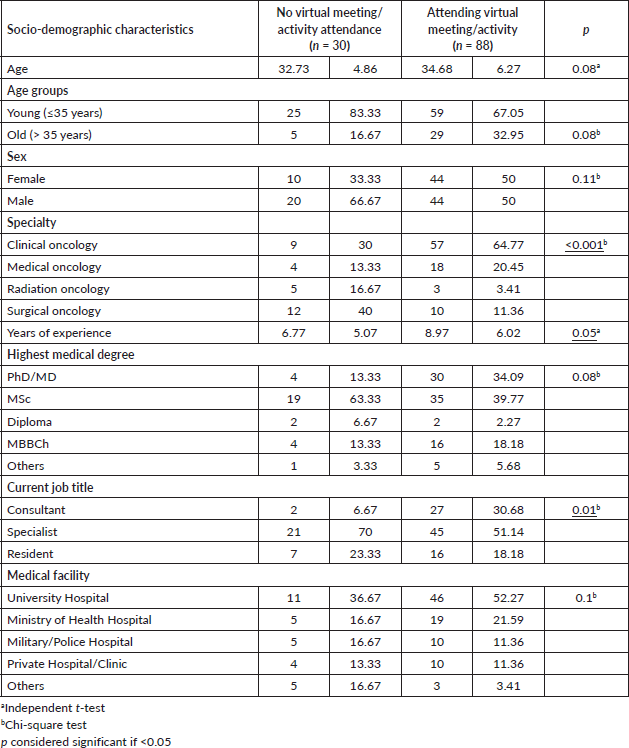
Supplementary Table 2. Needs and expectations for the future of virtual educational meetings and activities in the post-COVID-19 world (n = 118).
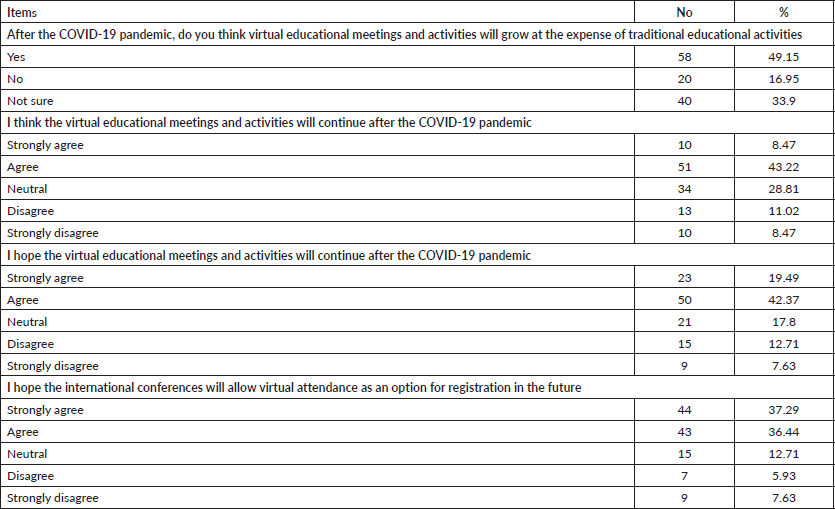
Supplementary Table 3. Correlation between the socio-demographic characteristics of participants and the degree of perception about virtual education after the COVID-19 pandemic.
